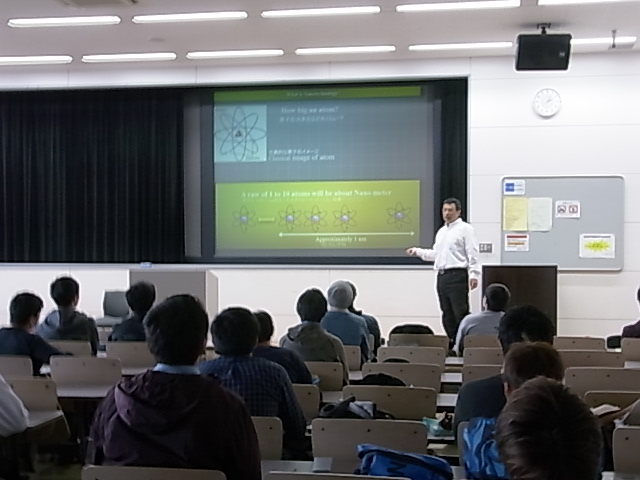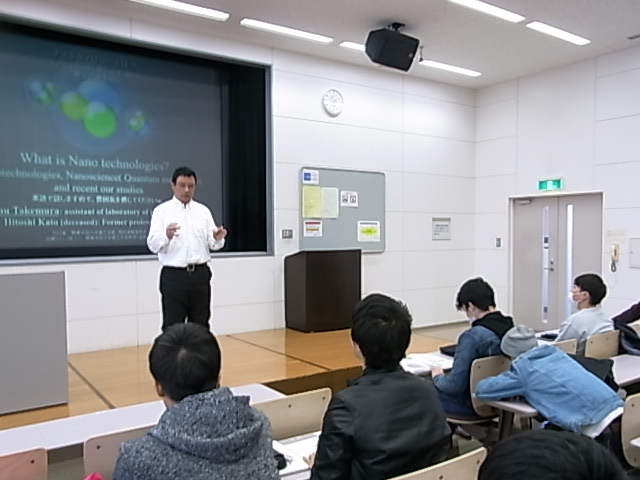ミニ講演会「What Is Nano Technology?:
The Familiar Technology and Nano-Scale Materials」 -共通科目コース- イベント
第15回理工学部、建築・環境学部教養学会主催「理系学生のための英語公開ミニ講演会」
(English Lecture Meetings for Science-Major Students)
What Is Nano Technology?:
The Familiar Technology and Nano-Scale Materials
講師: 理工学部理工学科 竹村 進 先生
理工学部、建築・環境学部教養学会では、2017年10月30日に理工学部理工学科、竹村進先生をお迎えし、上記のタイトルにおいて英語公開講演会を開催した。当初、10月23日に予定していた本学、竹村進先生による英語講演会は台風のために延期され、10月30日に実施された。
先にお亡くなりになられた加藤ひとし先生との共同発表の形で行われた本発表で、竹村先生はナノテクノロジーとは何かという問いかけからお話を始められ、小さな世界の科学の歴史をデモクリトス、ラボアジェ、ダルトンなどの名をあげながら説明され、「ナノ」が「小さい」という意味のラテン語の語源に由来する接辞であること、1ナノメートルは10億分の1メートルであること(原子の大きさを一億倍すると野球のボールになり、野球のボールを一億倍すると地球の大きさになるというスケール感覚で示された。)、原子を1個から十個並べた大きさがおおよそ1ナノメートルであることなどを説明された。
また、古典的な原子の図は実際の形を表してはおらず、量子論によるイメージにより量子力学の理論に合致した原子の姿が描けること、蛍光顕微鏡に至る顕微鏡の話、可視光線の波長の限界を超えるために電子ビームやイオンビームをプローブとして用いたナノ粒子の観察方法について、ナノ構造を作る2つの方法(大きなものからナノ構造をつくるTop-Down方式と小さなものを集めてナノ構造を作るBottom-Up 方式)について、ナノスケールの世界においては物理、化学、生物学などの研究分野の境界線があいまいになっており、ナノテクノロジーの研究の影響が情報工学や医学の領域にも浸透していること、「シュレディンガーの猫」と呼びならわされる概念的な実験の示すパラドクスが「状態の共存」という概念を肯定すること(物質の持つ波動とは確率の波であるという仮定を支持すること)などについて英語でのご講演をされた。
聴講者の多くは化学、生物学、建築学などを専攻とする学生であったが、広い学問領域にわたる様々な話題を含むご講演内容からナノテクノロジーの研究の広範な影響力と大きな可能性を認識することが出来た。
英語のご講演の後には、日本語でも若干ご説明を補足され、先生ご自身が実際にナノテクノロジー実験に携わる中で感じられた問題点、ナノテクノロジーの現実の応用例、故、加藤ひとし先生との共同研究などについて更に言及され、聴講者の理科系マインドを大いに刺激された。
当日の聴講者よりは以下の質問が英語で行われ、竹村先生はすべての質問にお答えになられた。
(聴講者よりの当日の質問)
Q. Aren’t there any risks in developing Nanotechnology?
Q. What are concrete applications of Nanotechnology in our daily life?
Q. What is the safety of cosmetics in which nanotechnology is used, or the risks of such products?
Q. In recent years, attention is directed to the microchip which is inserted into the human body for monitoring it. I would like to know if there are any risks with using such a device and how we could deal with them.
Q. Is it still difficult to produce nanotubes on a large scale?
Q. We learned about the world’s smallest thermometer in the textbook.
My question is for what purpose it is used?
Q. Nanomaterials such as carbon nanomaterials and nanowires are now in use. What sort of other nanomaterials do you think will be produced in the future?
Q. As we develop and control smaller and smaller materials, do you think that Nanotechnology will be faced with the limit on the size of the objects that it can manipulate in the future?
Q. What do we need to further advance Nanotechnology from now on?
Q. Is it possible to solve environmental problems with Nanotechnology?
Q. Can we develop with Nanotechnology a compact camera about the size of
a fly which we see in the movies?
Q. It is said that nano-lithography is used in electric circuits.
Are there any other nano-products that are used in our daily life?
Q. Can you make thermometers using gallium?
Q. Takemura-sensei, when you conduct your research in Nanotechonology,
what are the things you are most careful about?
Q. I’m interested in “generation of skin” and the latest technology of nano chip. The experiments for this technology was successful in August this year with pigs and mice as subjects. My question is when it will be possible to put this technology into practice and realize human skin generation.
Q. Is it possible to know the structures of genes more in detail with Nanotechnology?
Q. Takemura-sensei, in which area other than medical science do you think that Nanotechnology will be most useful in the near future?
Q. I have learned about Nano-toxicology, a study of health risks for humans caused by Nanotechnology, and found that Nanotechnology may cause various effects on the human body. Takemura-sensei, what is your take on this problem?
Q. Takemura-sensei, how do you think Nanotechnology will change the development of medical science in the near future?
(2017年10月30日開催)

